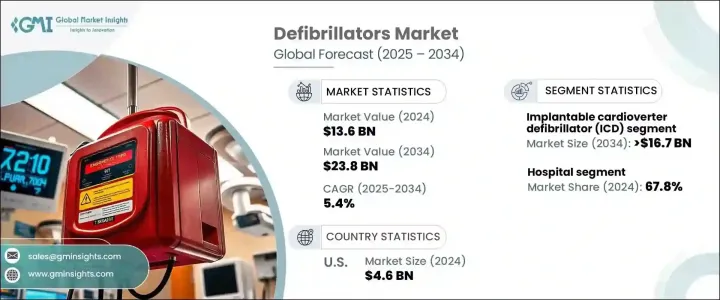
세계의 제세동기 시장은 2024년까지 136억 달러에 이른 것으로 평가되었고, 2025년부터 2034년까지 CAGR 5.4%로 견조한 성장이 전망되고 있습니다.
이 꾸준한 성장은 심혈관 질환의 유병률 증가, 구명 의료기기에 대한 의식 증가, 세계의 노화가 주요 요인입니다. 심장 관련 질병은 여전히 세계의 주요 사인 중 하나이기 때문에 제세동기에 대한 수요는 증가의 길을 따라가고 있습니다. 또한, 자동 체외식 제세동기(AED)나 이식형 제세동기(ICD)의 개발 등 기술 진보에 의해 이러한 구명 기구는 보다 효과적이고 사용하기 편리한 것이 되고 있습니다. 특히 AED는 공중보건 활동에 있어 매우 중요한 도구로 여겨지며, 공공공간과 의료시설이 더 많은 장비를 갖추고 있습니다. 이러한 추세는 필수적인 구명 장비에 대한 접근성을 개선하고 궁극적으로 갑작스런 심정지 및 기타 심장 관련 긴급 상황에 대한 대응 시간을 개선하는 것을 목표로 하는 정부 정책과 이니셔티브에 의해 뒷받침됩니다.

제세동기 시장은 이식형 제세동기(ICD)와 체외식 제세동기 등의 제품 유형에 따라 구분됩니다. 심장 리듬을 지속적으로 모니터링하고 갑작스런 심장 정지를 방지하기 위해 필요할 때 충격을 주도록 설계된 ICD는 예측 기간 CAGR 5.2%로 성장할 것으로 예측됩니다. 2034년까지 이 분야는 167억 달러 시장 가치를 창출할 것으로 예상됩니다. ICD는 특히 위험이 높은 환자 집단과 임상 현장에서 널리 채택되어 인명 구조에 중요한 역할을 하는 것으로 뒷받침됩니다.
| 시장 규모 | |
|---|---|
| 시작 연도 | 2024년 |
| 예측 연도 | 2025-2034년 |
| 시작 금액 | 136억 달러 |
| 예측 금액 | 238억 달러 |
| CAGR | 5.4% |
최종 사용자별로는 병원이 제세동기 시장을 독점하고 있으며, 2024년에는 67.8%라는 큰 점유율을 차지했습니다. 병원은 여전히 응급 의료 및 중증 환자 치료의 주요 장소이며 심장 응급 상황에 신속하게 대응하기 위해 고급 제세동기가 필수적입니다. 훈련받은 의료 전문가를 이용할 수 있는 것이 이러한 환경에서의 제세동기 채용을 더욱 뒷받침하고 있습니다. 또한 외래수술센터 등 다른 의료시설에서도 이러한 구명기술에 대한 투자가 증가하고 있어 시장의 폭넓은 성장에 기여하고 있습니다.
미국에서 제세동기 시장은 2024년에 46억 달러를 창출해 2034년까지 연평균 복합 성장률(CAGR) 4.5%로 성장할 것으로 예측됩니다. 미국은 강력한 헬스케어 인프라, 의료 기술에 대한 많은 투자, 제세동기의 보급을 장려하는 지원 정책의 혜택을 누리고 있습니다. 공공 부문과 민간부문의 이니셔티브에 의해 공공공간이나 의료시설에 AED의 설치가 추진되고 있으며, 궁극적으로는 갑작스런 심정지에 대한 긴급 대응의 속도와 효율을 높이는 것으로 생존율을 향상시키고 있습니다.
The Global Defibrillators Market is expected to reach USD 13.6 billion by 2024 and is projected to grow at a robust CAGR of 5.4% from 2025 to 2034. This steady growth is largely driven by the increasing prevalence of cardiovascular diseases, growing awareness of life-saving medical devices, and an aging population worldwide. As heart-related conditions remain one of the leading causes of death globally, the demand for defibrillators continues to rise. Additionally, advancements in technology, including the development of automated external defibrillators (AEDs) and implantable cardioverter defibrillators (ICDs), are making these life-saving devices more effective and user-friendly. AEDs, in particular, are increasingly seen as a crucial tool in public health initiatives, with more public spaces and medical facilities being equipped with these devices. This trend is also fueled by government policies and initiatives aimed at improving access to essential life-saving devices, ultimately enhancing response times to sudden cardiac arrest and other heart-related emergencies.

The defibrillators market is segmented based on product types, including implantable cardioverter defibrillators (ICDs) and external cardioverter defibrillators. ICDs designed to continuously monitor heart rhythms and deliver shocks when necessary to prevent sudden cardiac arrest, are projected to experience a CAGR of 5.2% over the forecast period. By 2034, this segment is expected to generate a market value of USD 16.7 billion. The widespread adoption of ICDs, particularly in high-risk patient populations and clinical settings, underscores their critical role in saving lives.
| Market Scope | |
|---|---|
| Start Year | 2024 |
| Forecast Year | 2025-2034 |
| Start Value | $13.6 Billion |
| Forecast Value | $23.8 Billion |
| CAGR | 5.4% |
In terms of end users, hospitals dominate the defibrillator market, holding a substantial share of 67.8% in 2024. Hospitals remain the primary settings for emergency and critical care, where advanced defibrillator devices are indispensable for swift response to cardiac emergencies. The availability of trained medical professionals further drives the adoption of defibrillators in these environments. Additionally, other healthcare facilities, such as ambulatory surgical centers, are increasingly investing in these life-saving technologies, contributing to the broader growth of the market.
In the U.S., the defibrillators market generated USD 4.6 billion in 2024 and is expected to grow at a CAGR of 4.5% through 2034. The U.S. benefits from a strong healthcare infrastructure, substantial investments in medical technologies, and supportive policies that encourage the widespread use of defibrillators. Public and private sector initiatives are driving the integration of AEDs into public spaces and healthcare facilities, ultimately improving survival rates by enhancing the speed and efficiency of emergency responses to sudden cardiac arrest.